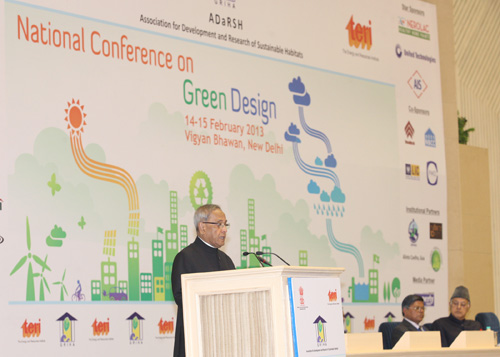Vigyan Bhawan, New Delhi : 14.02.2013 Speech By The President Of India, Shri Pranab Mukherjee At The Inauguration Of National Conference On Green Design
: 14.02.2013
 (73.17 KB)
(73.17 KB) I am indeed happy to be present this morning at the opening of the 4th GRIHA National Conference on Green Design today.
I am indeed happy to be present this morning at the opening of the 4th GRIHA National Conference on Green Design today.
Ladies & Gentlemen,
The continuing increase in the Indian population and growth of the Indian economy, along with rapid urbanization has led to an enormous demand for buildings. This in turn is leading to a huge increase in demand for electricity in new and existing buildings. Simultaneously, the diminishing availability of water is becoming a serious challenge.
Buildings consume a substantial amount of energy. In 2011-12 the share of construction sector in GDP was about 7.8%. However, the share of electricity consumption by the buildings sector alone is about 35% of the total electricity consumption in India. As per reports of the Planning Commission, the energy supply must grow at a rate between 6.5 per cent and 7 per cent per annum in order to meet the 9 per cent growth rate (during the Twelfth Five Year Plan) of the Indian economy. This means that India would need to add about 76000 MW capacity of power (approximately 15000 MW power capacity per year) through the Twelfth Five Year Plan. This is not an easy task. Hence, it is essential that demand management becomes a priority. Therefore, increased energy efficiency in the building sector and utilization of renewable energy are key strategies to contain this form of growing energy demand.
To achieve sustainability, the policy makers at all levels need to address the environmental pressures due to increased demand for resources, and a rapidly changing climate. Several policy and regulatory mechanisms have been devised to address the urban challenges, and are being implemented through national plans and programmes. The Environmental Clearance process is in place to ensure efficiency in resource use for large projects. The Energy Conservation Building Code (ECBC) is also applicable to air conditioned commercial buildings with connected load more than 100 kW and the Solar Buildings Programme for Energy Efficient Buildings has been formulated for implementation by the designated State agencies and municipal bodies. However, much more needs to be done in this regard.
Ladies and Gentlemen,
A perceived notion of high costs of green buildings, lack of clarity in the domain of application, deficiencies in the area of integration and uniformity of various codes and standards, lack of disincentives for non-compliance, agencies and systems working in silos have added to the impediments in the implementation of sustainable habitats. Lack of awareness about the expected gains is also a major obstacle while ensuring large scale implementation of sustainable habitats. It is heartening to know that GRIHA is addressing these issues and gaps to a large extent.
It is imperative that in the light of looming challenges of water and electricity availability, States where a significant part of construction is yet to take place should ensure construction of sustainable habitats. All Central Ministries need to promote this in their respective sectors. Adoption of GRIHA by the Central Public Works Department (CPWD) and the National Building Construction Corporation Ltd. (NBCC) should give a fillip to both the public and private sector to construct environment friendly buildings in a big way. The urban bodies must also make certain aspects compulsory while introducing a set of incentives and disincentives so that developers fall in line and the bigger houses and complexes also follow this approach.
I congratulate The Energy and Resources Institute (TERI) and the Ministry of New and Renewable Energy (MNRE), Government of India on the development and implementation of GRIHA- the indigenous green building rating system of India. I also congratulate all the recipients of the GRIHA awards for demonstrating environmental responsiveness, energy efficiency and for making significant efforts to adopt renewable energy integration in their respective buildings. I hope others would emulate and benefit from the examples set through these buildings.
Ladies and Gentlemen,
I extend my best wishes for the success of this Conference and hope that the deliberations which will take place here, promote creation of sustainable habitats all over the country, the GRIHA way.
Thank you.
JAI HIND.








